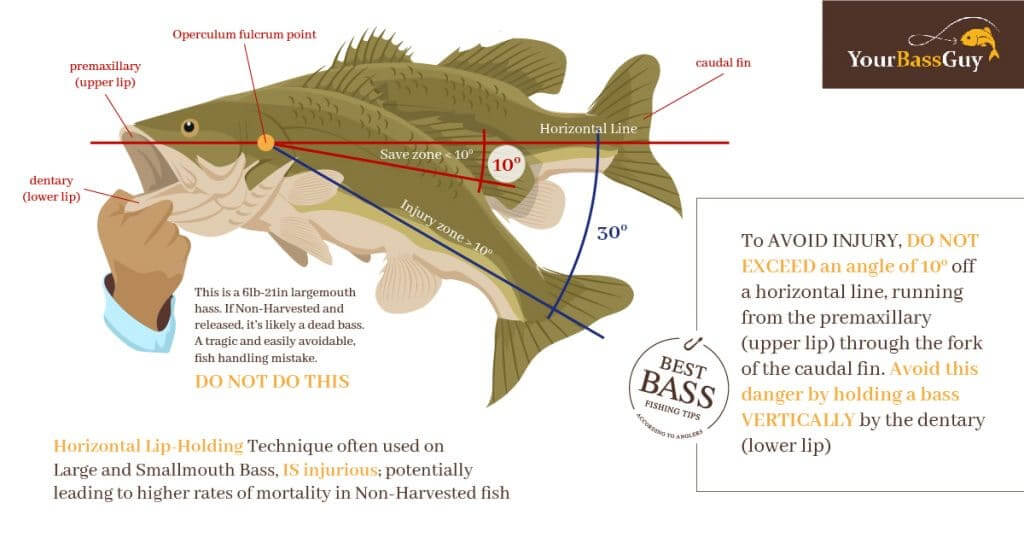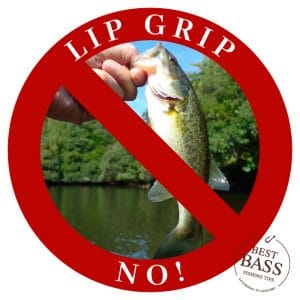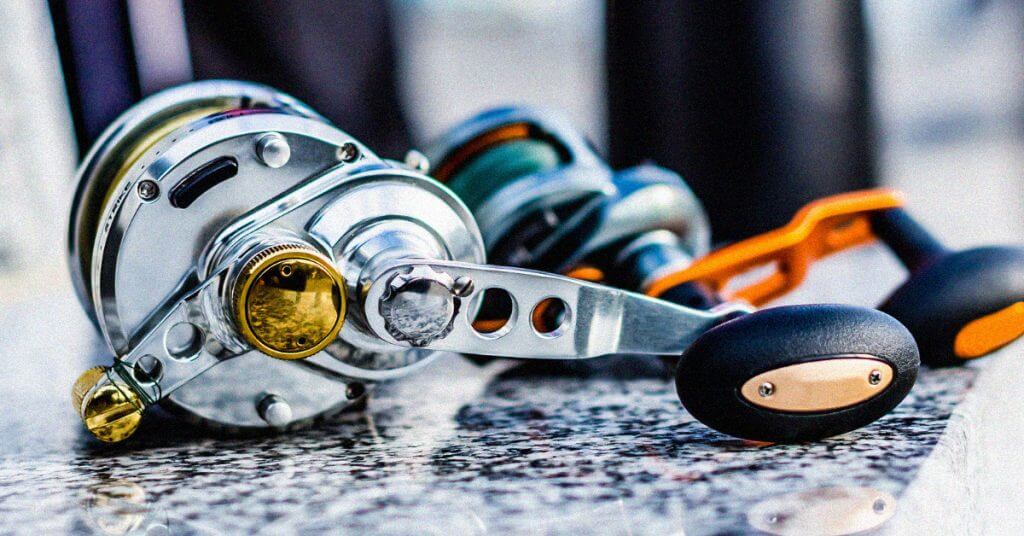You’ve snagged yourself a big bass, and you couldn’t be more proud to show it off, but holding it the wrong way can not only pose a risk to you but also to the bass.
Over the years, I’ve seen a lot of information pop up on and offline about the correct ways to hold bass, and I’ve discovered that most people do it wrong.
If you don’t properly understand how to hold a bass fish, you risk cutting yourself and even killing the bass when you put them back in the water.

Not knowing what to do with your hands can have you looking like Ricky Bobby in an interview on Talladega Nights.
As anglers, it’s our duty to protect the waters we fish and ensure we’re not causing any harm to the ecosystem swimming around below us.
If you’re fishing to catch and release, you need to understand how to hold a bass like a professional.
How to Hold a Bass
Holding a bass vertically is the safest way. The tail should be directly underneath the mouth so you don’t put too much pressure on the jaw. Place your thumb inside its mouth and grip its bottom lip. This allows the bass’s body to sit naturally so you don’t risk breaking its jaw.
Don’t miss this Youtube video demonstration from Anglers.com writer Wesley on how to correctly hold a bass.
Ways To Hold a Bass

Holding a bass might seem like the easy part of fishing, but it deserves some attention as well. If you don’t know how to hold a bass properly, you can hurt it or yourself. In a worst-case scenario, you’ll put the bass back in the water, thinking the fish is okay, but they won’t recover quickly enough, and they’ll die down there.
If you hold the bass at an angle greater than 10 degrees, you’re putting too much pressure on their jaw, which causes it to dislocate without you even knowing it. When this happens, the bass cannot close their jaw properly, which means they are unable to hunt. Long story short, if they can’t hunt, they can’t eat, and they will likely die.
You have two primary safe holding options, and either is okay. Let’s talk about some of the ways to hold a bass.
Vertical Hold
As mentioned above, this is the safest way to hold a bass. You’ll hold it with your finger in its mouth on the bottom lip and the rest of your fingers outside the mouth underneath the lip. The bass’s tail will hang below its body, so there is limited pressure on the jaw because you don’t need to bend it down to hold it properly.
Make sure you’re keeping a firm grip on the bottom jaw in the vertical position so it doesn’t slip away from you and don’t bend the jaw back too much, or you could damage it.
The reason why most people prefer this holding method is because it gives you the best of both worlds. There are two main areas you need to protect when holding a bass.
- Their jaw
- Their slime
Bass have a slime coating that covers their body and helps keep away diseases and infections. It’s a necessary part of their health, so if you handle them too much with your hands, you may remove some of that coating. Dropping the fish or laying them down in the grass or sand will also cause them to lose their coating.
Do your best to handle them with care, and the vertical method works well because it doesn’t require you to touch anything but their lip.
Horizontal Hold
If you have a large bass and you’re trying to get a trophy picture, you might go for a horizontal position. This hold provides more support so you can hold the bass up with your other hand. For this, you’ll put your thumb in its mouth, grabbing the lower lip.
While holding it vertically, you will then take your other hand and place it underneath the belly of the fish to support their weight. Make sure you’re not resting your hands on any fins while doing this. This hold works best for larger fish because it supports the weight of the fish.
I like this hold because it takes all the pressure off the lower jaw, and if you’re quick, you won’t have to handle the bass too much, so you won’t remove any of their slime protection. Just remember that every second you spend with the bass out of the water is another it takes the fish to recover when they get back in. Bass aren’t typical prey, but if a big fish sees that they are weak, it’s fair game.
Angled Hold

The angled hold is the one we want to avoid. This is where you hold the bass from their jaw at an angle greater than 10 degrees. When you do this, you will see that their mouth expands so much from the pressure of the hold is on that bottom lip. This hold will damage their jaw, and if they cannot close it properly, they will not be able to feed correctly.
Please do your best to prevent yourself from holding a bass this way. There’s no reason why you can’t place your other hand underneath the fish to protect it.
Also, when we’re pulling bass into the boat from the water, we’re all excited and caught up in the moment. Be careful how you’re handling them during this time as well.
Do Bass Have Teeth?
Yes, bass do have teeth. They are hard to see but pretty sharp. I like to compare them to the feeling of a shallow saw blade. While you can’t do a whole lot of damage to their teeth, you can get cut by the bass’s teeth if you don’t hold them properly.
Their teeth aren’t designed for chewing, but instead, they point inward, so when the bass closes their mouth, it traps their prey inside, and they can’t escape.
Make sure when you’re learning how to hold a largemouth bass, you don’t put your fingers too far into their mouth. Largemouth bass teeth usually run an inch or so from the end of the lip. If you know how to lip a bass, you shouldn’t have to worry about their teeth.
Finally, don’t keep them out of the water for too long. The longer you stand there trying to get the trophy picture of a lifetime, the more harm you’re doing the fish, and you’re increasing the likelihood of them throwing their body around, which can hurt you and the bass.
Expert Tips
Here’s a few of my own tips on properly holding a bass. As a bass angler, we all have guidelines that we follow pertaining to the ecosystem we fish. One that I’ve always taken seriously is my handling of the bass. Hopefully, these tips bring some issues to light and maybe even make you think a bit differently about how you handle fish in general.
Don’t Pull the Bass Into the Boat Using the Line.
I see new anglers do this all the time, and it drives me insane. The bass undergoes the tremendous stress of trying to flee your boat, and now you’re going to pick them up and slam them into the boat while they flop around at the bottom of your dirty and dusty boat. This is not only going to cause extra stress, but it will also remove a lot of their protective coating.
You should always net your bass while they’re still in the water and pull the hook out on the side of the boat with them in the net. This limits the amount of handling and damage you do to the fish.
Hurry Up!
Don’t stand there on Facebook Live with the bass you caught, take a few pictures, and get on your way. The longer you keep that bass out of the water, the longer you’re taking it to recover when it gets back. Take pride in the waters that you fish!
Final Thoughts
That’s all I’ve got for this one. I hope you found these bass fishing tips useful.
There are a million other resources online, but it all starts with the angler in the water which is handling the fish each day. Do your best, inform yourself, and always take pride in what you do.





Great articles I love to fish for largemouth bass on top water plugs thanks Vinnie f Long Island ny
I have seen some videos where people will let the bass breath in the water while still holding them by the mouth. They did this for big bass when they were going to get a weight but they wanted the bass to get a few good breaths in before they took more time with the bass out of the water. How do you do this without the bass getting away? This would be good for me to learn because I don’t have a live well.
Hey Josh, I honestly think it’s gambling to hold the bass in the water. One quick move and they’re gone.
If you don’t have a live well, look into some stringers! I wouldn’t recommend doing it for too long because you do have to puncture their mouth to get them on there.
You can also make a simple live well out of most coolers. Thanks for reading!